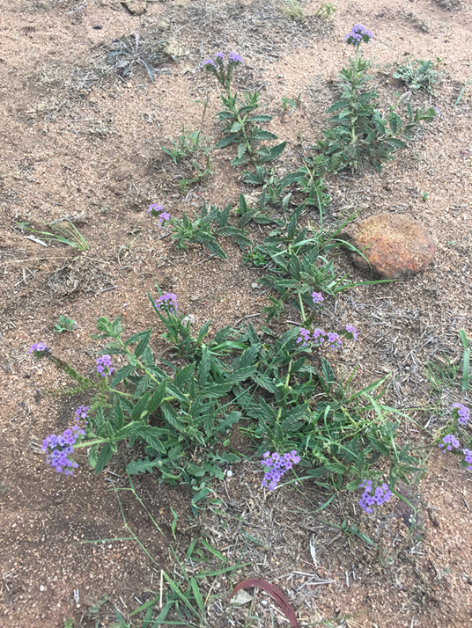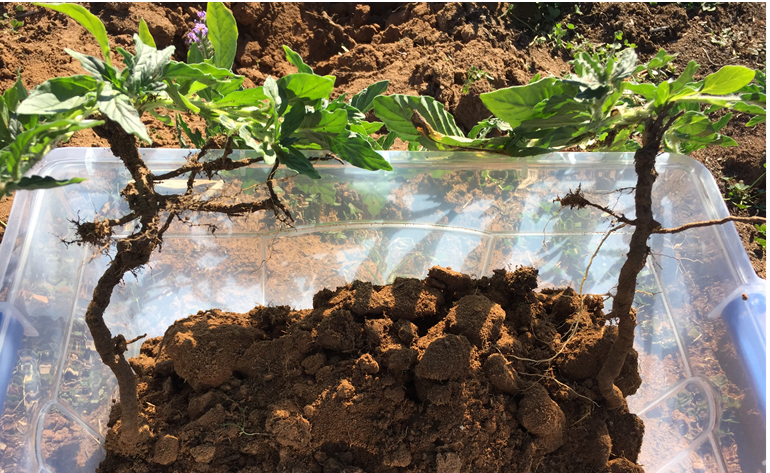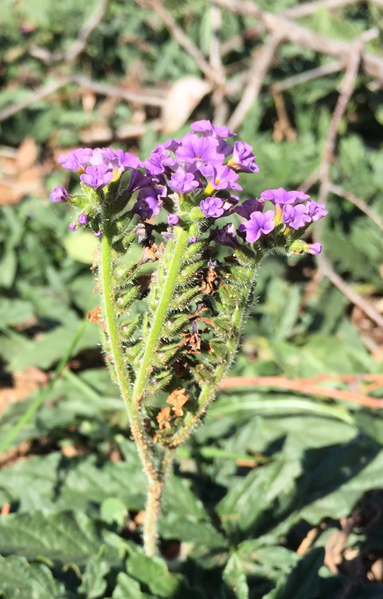Blue Heliotrope: A weed to watch out for
By Callen Thompson, Senior Land Services Officer – Mixed Farming
The plant
Blue heliotrope (Heliotropium amplexicaule) is a drought tolerant and poisonous weed which is taking advantage of the current conditions and spreading throughout Central West NSW. Once it takes over, it is difficult to control in bushland, pasture and cropping situations. Early identification and control is critical.

Figure 1: Blue Heliotrope
Blue heliotrope occupies over 110 000 hectares in NSW. It is unpalatable to stock, but when it is eaten, it can cause liver damage, photosensitisation or sudden death in pigs, horses, cattle, sheep and goats. Blue heliotrope is drought tolerant due to its long taproot and complex system of lateral roots that occur throughout the soil profile (figure 2). It is able to store energy in its roots and is often the first plant to respond after opening summer rain. Heliotrope robs moisture from desirable annual and perennial pasture plants.
Blue heliotrope is relatively easy to identify. It is a summer growing, prostrate perennial which can be 15 to30cm high and 30 to 200cm in diameter. The leaves are spear shaped and a dull green. The stem, like the leaves are hairy. The flower is possibly the most distinguishing feature, being bluish-purple with yellow centres. Like many plants in the Boraginaceae family, flowers are in dense clusters along one side of a coiled stalk, often referred to as a fiddle neck (figure 3).
Control
Blue heliotrope is difficult to control in cropping situations. Often in fallows, its hairy leaves limit herbicide uptake, which can be aggravated by dust held on the leaves. Often herbicides will only kill the top of the plant, leaving it to re-shoot from the root system. Broadleaf specific Chemicals such as 2,4-D can exacerbate this.

Figure 2: The large and complex root system of Blue Heliotrope make it well adapted to dry conditions (photo: C Thompson).
Limiting spread
Blue heliotrope is difficult to control, so limiting its spread is very important. It can spread by seed or by root fragments. Seed can stick to clothing or animals and can be found in fodder or on machinery. Some seed can be viable after travelling through animal’s digestive systems. Root fragments can be spread by machinery, particularly cultivation machinery or graders, as well as washed down stream and spread via waterways.
If blue heliotrope has established in a new area, it is important to control it before the population gets too high. Isolated plants can be dug up, but ensure that all roots are removed or they could re-shoot.
Chemical control
There are a number of different chemicals registered for spot spraying blue heliotrope. Care needs to be taken when using some of these products in bushland or legume dominant pastures as many broadleaf plants are susceptible to these products. Always consult your agronomist and read the label prior to using any herbicides.
Competitive pasture
One of the best ways to prevent establishment of heliotrope is by maintaining groundcover with a competitive pasture. By managing fertility and grazing pressure, you can reduce bare soil, reducing the opportunity for weeds to germinate and establish.

Figure 3: The “fiddle neck” appearance of the flower stalk is a distinguishing feature
Grazing control
If you are dealing with large areas of established blue heliotrope, control becomes more difficult. Cultivation is not a good option as it spreads root fragments, often causing a greater problem. Grazing can be used to help control blue Heliotrope. Sheep and goats can be used to manage heliotrope, provided a different group of animals is used each year. Merinos have the greatest tolerance and adult wethers should be used rather than breeding ewes or juveniles. Horses, pigs and cattle should never be used in the grazing management of blue heliotrope
If the paddock is completely overtaken by blue heliotrope and pasture re-establishment needs to take place, reduce weed seed banks by growing cereal crops for at least three years, with a strong focus on effective summer fallows. Be mindful that fallow applications containing 2,4-D may decrease the effectiveness of blue heliotrope control. Again, speak to an agronomist. Chose a perennial grass species that is most competitive in summer for re-sowing.
Biological control
Blue heliotrope leaf-beetle (Deuterocampta quadrijuga) is a biological control agent that eats Blue heliotrope. There has been some success with releases in the Capertree Valley, but to date limited success in the Central West of NSW. This is because the beetles will not establish and lay eggs on plants that are suffering from moisture stress. Therefore, the tough summers, which we experienced in the past, has somewhat limited naturalisation of the beetle. Conversely, an increased number of mild summers, like the last two seasons, will assist the spread of these beetles over time. Regardless, it is important to remember that the leaf beetle will not eradicate blue heliotrope, but with careful management, it may provide an extra management option.
Blue heliotrope is easiest to manage when it is moving into a new area. Be on the lookout and if you see it, control it early. For more information, check out the links below or contact your local LLS ag advisor.
Find out more about weed control and identifying weeds on your property.
NSW Department of Primary Industries and Regional Development links
- https://weeds.dpi.nsw.gov.au/Weeds/BlueHeliotrope
- https://www.dpi.nsw.gov.au/content/archive/agriculture-today-stories/ag-today-archives/february-2009/beetles-eat-blue-heliotrope